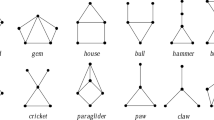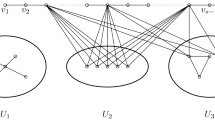Abstract
Let \(F_1\) and \(F_2\) be two disjoint graphs. The union \(F_1\cup F_2\) is a graph with vertex set \(V(F_1)\cup V(F_2)\) and edge set \(E(F_1)\cup E(F_2)\), and the join \(F_1+F_2\) is a graph with vertex set \(V(F_1)\cup V(F_2)\) and edge set \(E(F_1)\cup E(F_2)\cup \{xy\;|\; x\in V(F_1)\hbox { and } y\in V(F_2)\}\). In this paper, we present a characterization to \((P_5, K_1\cup K_3)\)-free graphs, prove that \(\chi (G)\le 2\omega (G)-1\) if G is \((P_5, K_1\cup K_3)\)-free. Based on this result, we further prove that \(\chi (G)\le \)max\(\{2\omega (G),15\}\) if G is a \((P_5,K_1+(K_1\cup K_3))\)-free graph. We also construct a \((P_5, K_1+( K_1\cup K_3))\)-free graph G with \(\chi (G)=2\omega (G)\).

Similar content being viewed by others
Data Availability Statement
No data applicable.
References
Brause, C., Doan, T., Schiermeyer, I.: On the chromatic number of \((P_5, K_{2, t})\)-free graph. Electron. Notes Discrete Math. 55, 127–130 (2016)
Tuza, Zs., Bacsó, G.: Dominating cliques in \(P_5\)-free graphs. Period Math. Hung. 21, 303–308 (1990)
Brause, C., Randerath, B., Schiermeyer, I., Vumar, E.: On the chromatic number of \(2K_2\)-free graphs. Discrete. Appl. Math. 253, 14–24 (2019)
Cameron, K., Huang, S., Merkel, O.: A bound for the chromatic number of (\(P_5\), gem)-free graphs. Bull. Aust. Math. Soc. 100, 182–188 (2019)
Cameron, K., Huang, S., Merkel, O.: An optimal \(\chi \)-bound for (\(P_6\), diamond)-free graphs. J. Graph Theory 97, 451–465 (2021)
Char, A., Karthick, T.: Coloring of \((P_5\), 4-wheel)-free graphs. Discrete Math. 345, 112795 (2022)
Choudum, S., Karthick, T., Shalu, M.: Perfect coloring and linearly \(\chi \)-bound \(P_6\)-free graphs. J. Graph Theory 54, 293–306 (2007)
Chudnovsky, M., Robertson, N., Seymour, P., Thomas, R.: The strong perfect graph theorem. Ann. Math. 164, 51–229 (2006)
Chudnovsky, M., Sivaraman, V.: Perfect divisibility and 2-divisibility. J. Graph Theory 90, 54–60 (2019)
Chudnovsky, M., Karthick, T., Maceli, P., Maffray, F.: Coloring graphs with no induced five-vertex path or gem. J. Graph Theory 95, 527–542 (2020)
Dong, W., Xu, B., Xu, Y.: On the chromatic number of some \(P_5\)-free graphs. Discrete Math. 345, 113004 (2022)
Dong, W., Xu, B.: Perfect divisibility of some \(P_5\)-free graphs, submitted
Erdős, P.: Graph theory and probability. Can. J. Math. 11, 34–38 (1959)
Esperet, L., Lemoine, L., Maffray, F., Morel, G.: The chromatic number of \(\{P_5, K_4\}\)-free graphs. Discrete Math. 313, 743–754 (2013)
Fouquet, J., Giakoumakis, V., Maire, F., Thuillier, H.: On graphs without \(P_5\) and \(\bar{P_5}\). Discrete Math. 146, 33–44 (1995)
Gyárfás, A.: On Ramsey covering-numbers, Infinite and Finite Sets (Colloq., Keszthely, 1973; dedicated to P. Erdös on his 60th birthday), Vol. II, Colloq. Math. Soc. Janos Bolyai, Vol.10, North-Holland, Amsterdam, pp. 801–816 (1975)
Gyárfás, A.: Problems from the world surrounding perfect graphs. Zastos. Mat. Appl. Math. 19, 413–441 (1987)
Gravier, S., Hoáng, C.T., Maffray, F.: Coloring the hypergraph of maximalcliques of a graph with no long path. Discrete Math. 272, 283–290 (2003)
Huang, S., Karthick, T.: On graphs with no induced five-vertex path or paraglider. J. Graph Theory 97, 305–323 (2021)
Randerath, B., Schiermeyer, I.: Vertex colouring and forbidden subgraphs: a survey. Graphs Combin. 20(1), 1–40 (2004)
Schiermeyer, I.: Chromatic number of \(P_5\)-free graphs: Reed’s conjecture. Discrete Math. 339(7), 1940–1943 (2016)
Schiermeyer, I.: On the chromatic number of (\(P_5\), windmill)-free graphs. Opuscula Math. 7, 609–615 (2017)
Schiermeyer, I., Randerath, B.: Polynomial \(\chi \)-binding functions and forbidden induced subgraphs: a survey. Graphs Combin. 35, 1–35 (2019)
Scott, A.D., Seymour, P.: Induced subgraphs of graphs with large chromatic number. I. Odd holes. J. Combin. Theory Ser. B 121, 68–84 (2016)
Scott, A.D., Seymour, P.: A survey of \(\chi \)-boundedness. J. Graph Theory 95, 473–504 (2020)
Scott, A. D., Seymour, P., Spirkl, S.: Polynomial bounds for chromatic number. IV. A near-polynomial bound for excluding the five-vertex path, submitted. See ArXiv:2110.00278
Sumner, D.P.: Subtrees of a graph and chromatic number. In: Chartrand, G. (ed.) The Theory and Applications of Graphs. Wiley, New York, pp. 557–576 (1981)
Wagon, S.: A bound on the chromatic number of graphs without certain induced subgraphs. J. Combin. Theory B 29, 345–346 (1980)
Acknowledgements
We thank the anonymous reviewers for valuable comments, and thank Dr. Karthick for pointing out an error in our earlier version on the construction of some extremal graphs.
Funding
This work was supported by National Natural Science Foundation of China (No. 11931106 and 12101117) and by Natural Science Foundation of Jiangsu Province (No. BK20200344). Author Baogang Xu has received research support from National Natural Science Foundation of China. Author Yian Xu has received research support from National Natural Science Foundation of China and Natural Science Foundation of Jiangsu Province.
Author information
Authors and Affiliations
Contributions
All authors contributed to the study conception and design. Material preparation, data collection and analysis were performed by WD, BX and YX. The first draft of the manuscript was written by WD, BX and YX, and all authors commented on previous versions of the manuscript. All authors read and approved the final manuscript.
Corresponding author
Ethics declarations
Conflict of Interest
The authors have no relevant financial or non-financial interests to disclose.
Additional information
Publisher's Note
Springer Nature remains neutral with regard to jurisdictional claims in published maps and institutional affiliations.
Supported by NSFC No. 11931106 and 12101117, and by NSFJS No. BK20200344.
Rights and permissions
Springer Nature or its licensor (e.g. a society or other partner) holds exclusive rights to this article under a publishing agreement with the author(s) or other rightsholder(s); author self-archiving of the accepted manuscript version of this article is solely governed by the terms of such publishing agreement and applicable law.
About this article
Cite this article
Dong, W., Xu, B. & Xu, Y. A Tight Linear Bound to the Chromatic Number of \((P_5, K_1+(K_1\cup K_3))\)-Free Graphs. Graphs and Combinatorics 39, 43 (2023). https://doi.org/10.1007/s00373-023-02642-y
Received:
Revised:
Accepted:
Published:
DOI: https://doi.org/10.1007/s00373-023-02642-y




